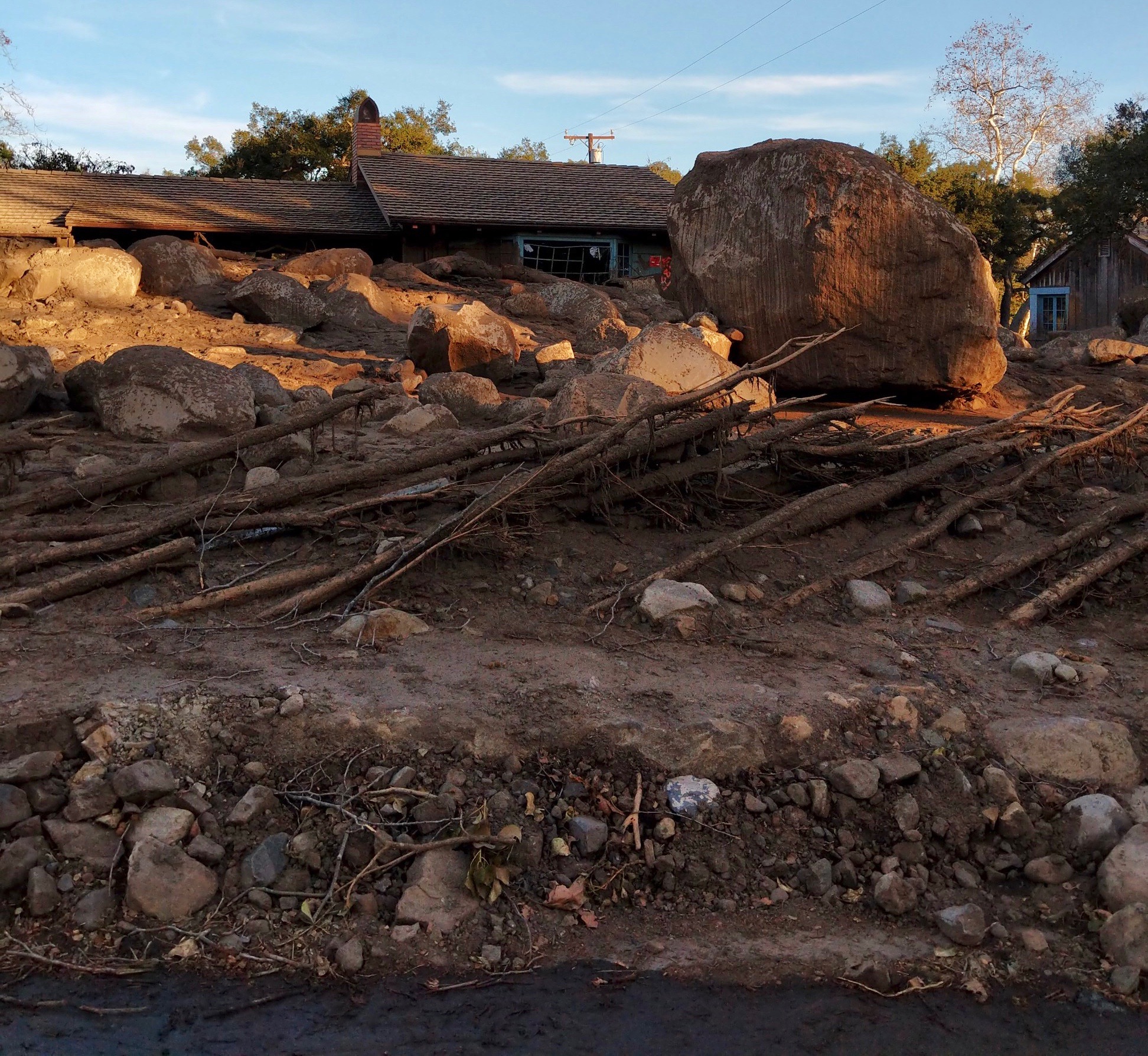 Aftermath of the January 9, 2018 debris flow in Montecito.
Aftermath of the January 9, 2018 debris flow in Montecito.
Photo by Douglas Jerolmack.
Dense suspensions are liquids that contain a large proportion of solid particles, and they exhibit a striking range of behaviors. Consider how the flow of water changes with the addition of cement, which is essentially rock powder. The suspension behaves as a solid (or is “jammed”) until a large enough force is applied. The viscosity of cement is not only much larger than water, but it also changes with how fast the concrete is flowing. Finally, these properties change over time due to surface-chemistry interactions and settling among the particles. Understanding this rich interplay of physics is at the frontier of the physics of “soft matter”, and formed the central theme of the “Physics of Dense Suspensions” program that took place at KITP in Spring 2018.
As a geophysicist, I had come to KITP for sabbatical to gain a deeper understanding of the theoretical physics underlying flows of Earth materials, such as rivers and landslides. Five days after my arrival, the Montecito debris flows occurred. Teams of geologists and engineers, some of them from UCSB, have since documented how this tragic event occurred; following the large Thomas fire which burned vegetation off the hillsides, an unusually intense rainfall triggered mudflows that coursed into the canyons above Montecito. There, these flows combined and picked up boulders from the channels to create powerful debris flows that overwhelmed the downstream channels, and poured out into Montecito with devastating effects. What is not yet understood is why these particular conditions formed the debris flows; without such an understanding, we lack the ability to predict the occurrence and magnitude of future events.
I joined Professor Tom Dunne (Bren School) and other UCSB faculty on a series of forensic field campaigns to reconstruct the mechanics of the debris flows, from their formation in the Santa Ynez mountains to their growth and acceleration downstream to their deposition in the town of Montecito. At first, this rather applied work was disconnected from the “basic science” activities at KITP. As time progressed, however, the two sides began to inform each other in unexpected ways. On the one hand, I realized that in trying to explain debris-flow dynamics we ran up against the frontier challenges in the physics of dense suspensions that were being studied at KITP. On the other hand, I discovered that program participants – many of them theoretical physicists – were more willing to engage in discussing this “messy” debris flow problem than I had anticipated. These exchanges helped to frame the debris flow problem in a more mechanistic manner: (1) Initiation requires turning a jammed granular solid into a dense suspension; (2) flow depends on how variations in grain size, and cohesive effects from clay and organic material, influence the complex changing viscosity; and (3) formation of a boulder front Aftermath of the January 9, 2018 debris flow in Montecito requires segregation of large particles. I am now conducting research in all three of these themes.
 |
Click above to play The Physics of Debris Flows: Making the Montecito Mudslides or watch at http://online.kitp.ucsb.edu/online/friends/jerolmack/
KITP provided an immersive environment for exploring these topics. On a blackboard outside of the Munger Residence, my graduate student and I sketched out the necessary fluid- mechanical properties to produce mudflows capable of lifting boulders and running them out to such long distances from the mountain range. Each week, a talk by a program participant would inspire a series of conversations – often flowing out of Kohn Hall to the grills and foosball tables at the Munger Residence. Many of these led to new ideas or calculations that influenced our work on the debris flows.
A leading light in these discussions always was Bob Behringer; his incredible insight and creativity was matched by his patience, generosity and inclusiveness. His sudden passing in July of this year was devastating for all who knew him. His legacy will live on through all of the science and scientists he has inspired, including all participants at the Physics of Dense Suspensions program. My time at KITP has opened many doors, helping to draw the connections between the frontier problems in physics and those of Earth science.
- Douglas J. Jerolmack, Professor of Geophysics at University of Pennsylvania
KITP Newsletter, Fall 2018
